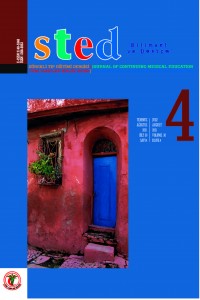Öz
Amaç: Anatomi sağlık bilimleri ile ilgili birçok bölümde verilen, temel tıp bilimi ve öğrenimi zor bir bilim dalıdır. Klinik birçok uygulamada anatomi bilimine hâkim olmak uygulayan kişinin işini kolaylaştırır. Bu yüzden fakültelerde verilen anatomi eğitiminin kalıcı olması oldukça önemlidir. Çalışmamızın amacı anatomi eğitimi ile ilgili öğrencilerin fikirlerini alarak, aksaklıkları saptamak ve literatüre katkı sağlamaktır.
Yöntem: Çalışmaya 2019-2020 eğitim-öğretim yılında Siirt Üniversitesi Sağlık Bilimleri Fakültesi Hemşirelik bölümünde anatomi dersini alan 176 öğrenci katılmıştır. Araştırma nitel yapıda betimsel bir çalışmadır. Nitel verilerin toplanması için araştırmacı tarafından hazırlanmış yarı yapılandırılmış görüşme formundan yararlanılmıştır. Araştırmada elde edilen verilerin değerlendirilmesinde içerik analizi kullanılmıştır.
Bulgular: Öğrenciler aldıkları anatomi eğitiminin zor olduğunu düşünmektedir. Teorik derslerin yeterli, pratik derslerin yetersiz olduğu öğrenciler tarafından ifade edilmiştir. Öğrencilerin büyük bir kısmı anatomi dersinde öğrendikleri bilgilere mesleki yaşamlarında sıklıkla karşılaşacaklarını ve anatomi dersinin klinik uygulamalar için gerekli olduğunu düşünmektedir. Teknolojik araçlarla entegre edilmiş yardımcı ders araçlarının kullanılmasıyla, dersinin niteliğinin ve kalıcılığını arttıracağı ifade edilmiştir.
Sonuçlar: Anatomi bilimi ile ilgili; dersin verilme şekli, teorik ve pratik ders saatleri, müfredatın içeriği gibi birçok konuda fikir ayrılıkları mevcuttur. Bu sebeple anatomi dersi ile ilgili öğrenci görüşlerinin bilinmesi önemlidir. Yapılan çalışmanın özellikle Sağlık Bilimleri Fakültelerinde verilen anatomi dersinin geliştirilmesini sağlayacağını ve öğreticilere yol göstereceğini düşünmekteyiz.
Anahtar Kelimeler
Kaynakça
- 1. Dunning D, Heath C, Suls JM. Flawed Self-Assessment: Implications for Health, Education, and the Workplace. Psychol Sci Public Interest. 2004;5(3):69-106.
- 2. Usun S. Dünyada ve Türkiye’de bilgisayar destekli öğretim. Ankara: Pegem; 2000.
- 3. Gözil R, Özkan M, Bahçelioğlu D, Kadıoğlu E, Çalgüner H, Öktem E, et al. Gazi üniversitesi tıp fakültesi 2. Sınıf öğrencilerinin anatomi eğitimini değerlendirmeleri. Tıp Eğitimi Dünyası. 2006;23.
- 4. Arı İ, Şendemir E. Anatomi Eğitimi Üzerine Öğrenci Görüşleri Uludağ Üniversitesi Tıp Fakültesi Dergisi 2003;29(2):11-4.
- 5. Warren W, Brinkley JF. Knowledge-based, interactive, custom anatomical scene creation for medical education: the Biolucida system. AMIA Annu Symp Proc. 2005:789-93.
- 6. Drake L, Vogl A, Mitchell A. Gray's anatomy for students. İstanbul: Güneş Tıp Kitapevi; 2016.
- 7. Atay E, Çınar S, Bozkurt Ö, Tokpınar A, Soysal H, Doğan U. Questıonnaıre: socıo-demographıc characterıstıcs of semester 1 medıcal students and theır opınıons about anatomy educatıon. Journal of health scıences. 2016;25(24):24-8.
- 8. Phillips LG. Anatomy - How Much or How Little and Taught by Whom. Am Surgeon. 1987;53(9):540-2.
- 9. Uygur R, Çağlar V, Topçu B, Aktaş S. Anatomi eğitimi hakkında öğrenci görüşlerinin değerlendirilmesi. International Journal of Basic and Clinical Medicine 2013;1(2):94-106.
- 10. Büyüköztürk Ş, Çakmak E, Akgün Ö, Karadenİz Ş, Demİrel F. Bilimsel Araştırma Yöntemleri. Ankara: Pegem; 2014.
- 11. Fielding NG. Qualitative Data-Analysis - a User-Friendly Guide for Social-Scientists - Dey,I. Sociology. 1994;28(2):607-8.
- 12. Yıldırım A, Şimşek H. Sosyal bilimlerde nitel araştırma yöntemleri. Ankara: Seçkin yayıncılık; 2006.
- 13. Turney BW. Anatomy in a modern medical curriculum. Ann R Coll Surg Engl. 2007;89(2):104-7.
- 14. Sindel M, Şenol F, Gürpınar E. Akdenİz Üniversitesi Tip Fakültesinde anatomi Eğitiminin Öğrenciler Tarafından Değerlendirilmesİ Tıp Eğitimi Dünyası 2008;28:31-8.
- 15. Golenhofen N, Heindl F, Grab-Kroll C, Messerer DAC, Bockers TM, Bockers A. The Use of a Mobile Learning Tool by Medical Students in Undergraduate Anatomy and its Effects on Assessment Outcomes. Anat Sci Educ. 2020;13(1):8-18.
- 16. Noguera JM, Jimenez JJ, Osuna-Perez MC. Development and evaluation of a 3D mobile application for learning manual therapy in the physiotherapy laboratory. Comput Educ. 2013;69:96-108.
- 17. Hopkins R, Regehr G, Wilson TD. Exploring the Changing Learning Environment of the Gross Anatomy Lab. Academic Medicine. 2011;86(7):883-8.
- 18. Özdemir S, Cankur N, Kurt M. Tıp Fakültesi Öğrencilerinin Anatomi Uygulamaları Hakkındaki Görüşleri: Bir Geri Bildirim Örneği. Uludağ Üniversitesi Tıp Fakültesi Dergisi 2001;27:39-42.
- 19. Sabancıogulları V, Cimen K, Dogruyol G, Tastemur Y, Otag İ, Sonmez M, et al. Recommendations of 5th-grade Medical Faculty students about clinical anatomy course Cumhuriyet Medical Journal 2017;39(4):671-4.
- 20. Waterston SW, Stewart IJ. Survey of clinicians' attitudes to the anatomical teaching and knowledge of medical students. Clin Anat. 2005;18(5):380-4.
- 21. Moxham BJ, Plaisant O. Perception of medical students towards the clinical relevance of anatomy. Clinical Anatomy. 2007;20(5):560-4.
- 22. Pabst R, Nave H, Rothkotter HJ, Tschernig T. Evaluation of the medical curriculum: Why, when, by whom and for whom should questionnaires be used. Eur J Morphol. 2001;39(4):237-9.
- 23. Miller SA, Perrotti W, Silverthorn DU, Dalley AF, Rarey KE. From college to clinic: reasoning over memorization is key for understanding anatomy. Anat Rec. 2002;269(2):69-80.
- 24. Robert S, Stephen W, Darrell G. The Importence of Anatomy in Health Professions Education and The Shorthage of Qualified Educators. Academic Medicine. 2005;80:349-51.
- 25. Pawlina W, Lachman N. Dissection in learning and teaching gross anatomy: rebuttal to McLachlan. Anat Rec B New Anat. 2004;281(1):9-11.
- 26. Gurpinar E, Musal B, Aksakoglu G, Ucku R. Comparison of knowledge scores of medical students in problem-based learning and traditional curriculum on public health topics. BMC Med Educ. 2005;5(1):7.
- 27. Pickering JD. Measuring learning gain: Comparing anatomy drawing screencasts and paper-based resources. Anat Sci Educ. 2017;10(4):307-16.
- 28. Tworek JK, Jamniczky HA, Jacob C, Hallgrimsson B, Wright B. The LINDSAY Virtual Human Project: An immersive approach to anatomy and physiology. Anat Sci Educ. 2013;6(1):19-28.
- 29. Wu P, Hwang L, Su YM. A context-aware mobile learning system for supporting cognitive apprenticeships in nursing skills training. International Forum Of Educational Technology & Society. 2012.;15:223-36.
- 30. Chang A, Ghose R, Quinn R, Anolik A, Kyer L, Mazhani A, et al. Use of Mobile Learning by Resident Physicians in Botswana. Telemedicine and e-health. 2012 18(1):11-3.
- 31. Bolatli Z, Korucu A. Determining the Academic Achievement of Students Who Use Flipped Classroom Method Supported by a Mobile Application and Their Views on Collaborative Learning. Bartın University Journal of Faculty of Educatio. 2020;9:229-51.
Ayrıntılar
| Birincil Dil | Türkçe |
|---|---|
| Konular | Sağlık Kurumları Yönetimi |
| Bölüm | Orjinal Araştırma |
| Yazarlar | |
| Yayımlanma Tarihi | 7 Eylül 2021 |
| Yayımlandığı Sayı | Yıl 2021 Cilt: 30 Sayı: 4 |


